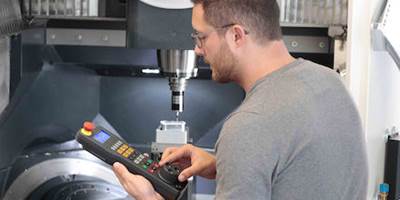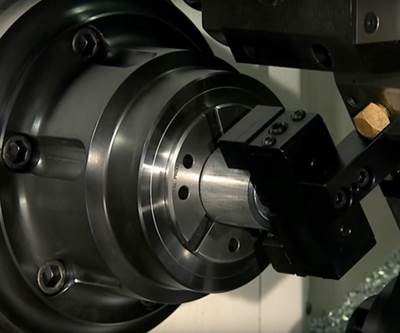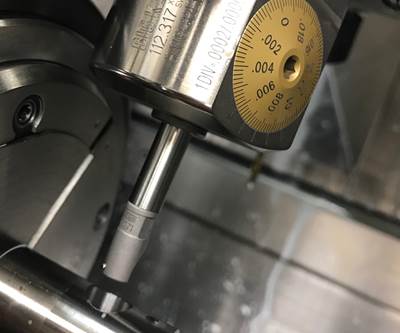Zero-Adjustment Bar Pullers Simplify Turning Automation
Spring-loaded grippers and adjustable programming are enabling bar pullers to fulfill their promise to save time and money in CNC turning automation.
Share





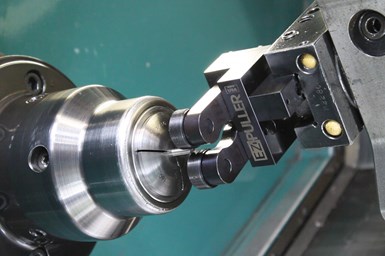
The Accudyne EZ-Puller is one of a new generation of bar pullers that handles different bar sizes with only a few numerical substitutions in G-code. Images courtesy of Accudyne.
What is a bar puller? This option for CNC turning automation might not be as popular as its cousin, the bar feeder, but it is an increasingly viable option for many shops working with high production numbers. Whereas old models of bar pullers could be time-consuming to set up, newer zero-adjustment models can pull different shapes and sizes of bar stock with only a few minor G-code substitutions.
Bar Puller Basics and Benefits
A bar puller is typically a device or tool mounted in the turret of a CNC turning center. The turning center’s computer activates the bar puller’s subroutine at the end of each turning program loop, with the puller using its grippers to engage, then pull barstock through the spindle along the Z-axis. The lathe’s chucking system opens, and the turret moves along the Z-axis to the desired length. The chucking system finally clamps the workpiece, and the bar puller tool retracts.
Because they mount inside the machine, bar pullers do not require floor space. This is in stark contrast to bar feeders, which can take up different amounts of space depending on the size of the CNC lathe.
Cost is another advantage. Daniel Kenner, founder and owner of Accudyne Corporation, says modern bar pullers tend to sell for under $1,500, while entry-level bar feeders can start at $8,000 and go up in price from there.
Kenner says his company’s bar puller only requires users to change a few numbers in the program when going from one bar size to another, with no special changes required when changing between round, square and hex stock.
Setup is also easier for bar pullers, which require less work than bar feeders to mount in a machine or synchronize with a machine interface. Having fewer moving parts than bar feeders also reduces maintenance costs and the risk of malfunctions.
With these advantages, why don’t bar pullers dominate the market? Kenner responds that most bar pullers to date have required manual adjustment or used coolant setups with stringent coding requirements. Manual adjustments require turning off the machine, opening it up and moving the grippers to fit the specific bar size and shape every time the bar size or type changes. Pullers with a coolant setup rely on an M function in the program to actuate the grippers, with different spindle orientation M functions for square or hex stock. Errors in these functions can result in tool damage. Another style of bar puller uses a cup that feeds over the end of the material — and which users must change for differently sized bars.
Zero-Adjustment Advancements
New bar pullers, such as Accudyne’s EZ-Puller Expanded Capacity, offer adjustable programming and grippers to make bar pulling less finicky. Kenner says his company’s bar puller requires users to alter only a few numbers in the program when changing bar sizes, and that it does not require any special codes when switching between bars with different shapes and sizes.
This particular puller also provides an example of how a cam and lifter setup can help ensure wide application compatibility. Two circular, serrated grippers hold on to the materials. These grippers are constructed from A2 tool steel hardened to between 58 and 62 Rockwell, and are mounted at the end of spring-loaded, movable arms. These arms pivot on a pivot pin as the grippers advance over the outside of the material — this pivoting motion compresses a urethane spring inside the body of the tool. The spring provides a reactive force that puts a load on the grippers, which in turn provide the gripping force that holds the material as it advances through the chuck.
The urethane springs can withstand several hundred thousand pulls before needing replacement, and the body of the tool is 4140 alloy steel, pre-heat treated to about 28 Rockwell.
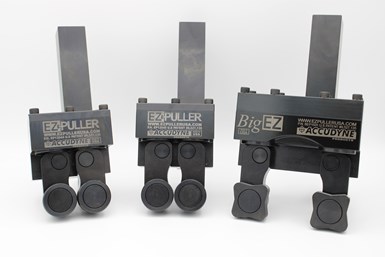
Daniel Kenner, founder and owner of Accudyne, urges potential buyers of bar pullers to check the compatible sizes of their prospective bar pullers. Compatibility ranges can change depending on the shape of the bar, and even adjustable bar pullers can only accommodate so large of a range.
Advice for Shops
First and foremost, Kenner recommends shops triple-check that they have the correct-size tool for the operations they are planning. Even the adjustable EZ-Puller has limits, with three different sizes for various applications. Compatible sizes can also vary depending on the shape of the bar stock, with hex and square bars having tighter compatibility ranges than round bars.
Shops interested in purchasing a bar puller should also check inside their machines to ensure they’ll have room for the tool. Different mounting options can help with tight spaces, but ultimately there will need to be clearance between the turret and the sheet metal inside the machine after the bar puller is mounted.
Ascertaining whether a particular bar puller can support multiple pulls is also important. “Multiple pulls” refers to the turning of a longer part that can’t be completed in a single chucking. In this case, the user incrementally pulls the bar after each operation to reveal fresh, unmachined material before rechucking and recommencing turning. Kenner says that the EZ-Puller supports multiple pulls, but also notes that users should read the limitations listed on Accudyne’s website.
Related Content
6 Machine Shop Essentials to Stay Competitive
If you want to streamline production and be competitive in the industry, you will need far more than a standard three-axis CNC mill or two-axis CNC lathe and a few measuring tools.
Read MoreInside a CNC-Machined Gothic Monastery in Wyoming
An inside look into the Carmelite Monks of Wyoming, who are combining centuries-old Gothic architectural principles with modern CNC machining to build a monastery in the mountains of Wyoming.
Read MoreOrthopedic Event Discusses Manufacturing Strategies
At the seminar, representatives from multiple companies discussed strategies for making orthopedic devices accurately and efficiently.
Read MoreWhere Micro-Laser Machining Is the Focus
A company that was once a consulting firm has become a successful micro-laser machine shop producing complex parts and features that most traditional CNC shops cannot machine.
Read MoreRead Next
5 Common Mistakes When Using CNC Machines
Spend enough time on the shop floor and you will see some of the same mistakes time and again.
Read MoreBar Pullers: A Lower-Capacity Alternative to Bar Feeders
For shops with limited space or funds, a bar puller may provide an effective and accessible way to automate a lathe.
Read MoreBoring Head Enables Sculpture Hardware to Be Machined on a Lathe
When small job shop Ansonia Manufacturing took on a tricky hardware component job for a “live” glass art sculpture, it realized a boring head would be needed to machine the part complete on its live-tool lathe.
Read More















.jpg;maxWidth=300;quality=90)



.jpg;maxWidth=300;quality=90)







